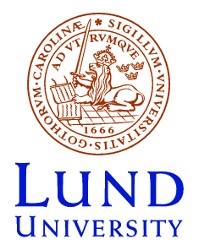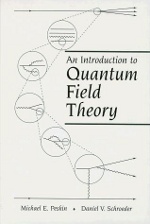
Introduction to
Quantum Field Theory
FYTN10, 7.5 hp
Spring 2013


|
Introduction to
|

|
|||||||||
This is a 7.5 hp course on Quantum Field Theory. It is an introductory course covering essentially the first six chapters of the book by Peskin and Schroeder (see below). The course is scheduled for the first part of the semester (January 21 to March 24).
The course will consist of approximately 20 lectures (2x45min) and 4-5 problem solving sessions.
| Date | Time | Place | Subject | Peskin and Schroeder | Hand-in exercise |
| Mon 21/1 | 13-15 | Sal NB | Introduction | ||
| Wed 23/1 | 10-12 | Sal NB | Classical field theory, Noether's theorem | Chapter 2.1-2.2 | |
| Fri 25/1 | 13-15 | Sal NB | Klein-Gordon field, causality and progator | Chapter 2.3-2.4 (7.1) | |
| Mon 28/1 | 13-15 | Sal NB | Perturbation theory and Correlation fcn's | Chapter 4.1-4.2 | |
| Wed 30/1 | 10-12 | Sal NB | Problems chapter 2 | - | nr 1 |
| Fri 1/2 | 13-15 | Sal NB | Wick's theorem, Feynman diagrams | Chapter 4.3-4.4 | |
| Mon 4/2 | 13-15 | Sal NB | Cross-sections | Chapter 4.5 | |
| Wed 6/2 | 10-12 | Sal NB | S-matrix from Feynman diagrams | Chapter 4.6 (7.2) | |
| Fri 8/2 | 13-15 | Sal NB | Dirac field, Weyl representation | Chapter 3.1-3.2 | nr 1 due |
| Mon 11/2 | 13-15 | Sal NB | Free particle solutions, Dirac bilinears | Chapter 3.3-3.4 | |
| Thu 14/2 | 10-12 | Sal NB | Problems chapter 4.1-4.6 | - | nr 2 |
| Fri 15/2 | 13-15 | Sal NB | Quantization of Dirac Field | Chapter 3.5 | |
| Mon 18/2 | 13-15 | Sal NB | Discrete symmetries of Dirac Field | Chapter 3.6 | |
| Wed 20/2 | 10-12 | Sal NB | Feynman rules for fermions | Chapter 4.7 | nr 2 due |
| Fri 22/2 | 13-15 | Sal NB | Yukawa theory and QED | Chapter 4.8 | |
| Mon 25/2 | 13-15 | Sal NB | e+e- -> mu+mu-: introduction | Chapter 5.1 | |
| Wed 27/2 | 10-12 | Sal NB | Problems chapter 3 and 4.7-4.8 | - | nr 3 |
| Fri 1/3 | 13-15 | Sal HUB | e+e- -> mu+mu-: helicity structure | Chapter 5.2 | |
| Mon 4/3 | 13-15 | Sal NB | Non-relativistic limit, Crossing symmetry | Chapter 5.3-5.4 | |
| Wed 6/3 | 10-12 | Sal NB | Compton scattering | Chapter 5.5 | nr 3 due |
| Fri 8/3 | 13-15 | Sal NB | Bremsstrahlung and electron vertex correction | Chapter 6.1-6.2 | |
| Mon 11/3 | 13-15 | Sal NB | Problems chapter 5 | - | nr 4 |
| Wed 13/3 | 10-12 | Sal NB | Electron vertex correction: UV and infrared divergences | Chapter 6.3-6.4 | |
| Fri 15/3 | 13-15 | Sal NB | Summation and interpretation of infrared divergences | Chapter 6.5 | |
| Mon 18/3 | 10-12 | Sal NB | Renormalisation and outlook | Chapter 7 | nr 4 due |
| Wed 20/3 | 10-12 | Sal NB | Question and Answer session | ||
| Thu 21/3 | - | - | Oral exams | ||
| Fri 22/3 | - | - | Oral exams |
Note: You have to have completed all hand-in exercises successfully before the oral exam.
Results from earlier years: spring 2011 , spring 2012
The main book will be